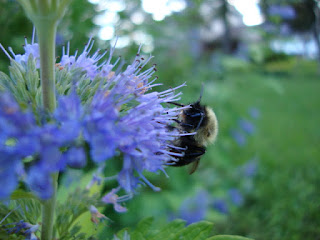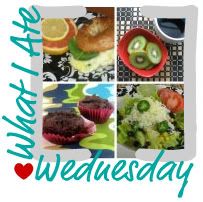Wow! We've done it! I've made it through my first ever week-long series (yes, I know it was technically a little longer) and you've read them as fast as I could post them (and if you need to catch up on any, here's pa
rts 1, 2, 3, 4 and 5!).
This final installment will be on the best part of beekeeping...harvesting, and ending with links to some of my favorite recipes.
Harvesting the Honey
The main
nectar flow is between April and June with another (smaller) flow in the fall.
Follow the pollen counts on the news/weather and when pollen is high, that is
when bees are making the most honey.
Do not
harvest until the honeycomb in capped. The honey has an18-20% moisture content
before it is capped and it will go rancid if harvested. The bees will quickly
flap their wings to dry the honey and then they know when it is at 16% moisture
and then they will cap the honey. (I don't know about you but this fact amazes me!)
Smoke the
bees. Pull out the frames that are capped and tap on the ground to remove bees
and place in empty box away from the hive.
Take to the
honey house at Brown’s Orchard ($5 to use). (Note: The floor is very sticky and
it is recommended to take a sheet to lay on the floor so your feet are not
stuck all the time!) Warm the caps with a heating gun or warm knife.
Put frames
in centrifuge to spin the wax and honey out of the frames. The honey will then
come out of a spigot at the bottom of the tub. Pour into bucket with strainer
over it to catch wax and debris (such as dead bees).
1 hive= 15 frames =
approximately 5 gallons= 65 lbs (40-60 lbs is average for one hive per year and honey is heavier than
water).
Allow the
honey to sit in the bucket for a few days. Any impurities will float to the top
and can be removed. Then store the honey in glass jars. Honey never spoils
(they have even found edible honey in Egyptian tombs!) but it can crystallize. If this happens, just put the jar in a warm
water bath and it will liquefy again. Once honey crystallizes it will
re-crystallize faster so you may wish to use it a.s.a.p.
You can
purchase your own equipment to harvest the honey but you are looking at
hundreds of dollars. There are hand crank varieties that are cheaper than
electric but a lot of work! You can make the hand crank ones go with a drill,
but I don’t fully understand how that all works :P
It IS legal
to sell honey from your home provided you have sourced it yourself and are not
selling it at any public location (market, etc.), just your home or stand.
Once you are
done harvesting for the year, leave the frames out so the hive is smaller for
the winter. You do need to be careful when storing used frames so that other
critters do not take up residence on them and they will most likely need
cleaned before usage the following year. (I need some more information on the best storage methods.)
Every 3
years get new frames as the bee’s wax absorbs pesticides from the pollen and
nectar and will turn black.
Uses/Recipes
Honey is great for soothing coughs, warding off colds and I've read taking raw honey can also help reduce seasonal allergies. Personally, I take raw honey whenever I feel run down or like I may be getting sick. Add some cinnamon for extra disease-fighting power, without any horrid antibiotics (honey is a natural antibiotic)!
I've also read that raw honey on cuts and wounds can help them heal faster and without infection although I have not tried it.
Use as a sweetener in drinks and recipes instead of sugar.
Use as a spread on toast, bagels or English muffins instead of (or in addition to) butter.
Chocolate Chewy Granola Bars (I love these! They are my go-to snack when I am hungry or just need something a little sweet, and oh so healthy!)





















